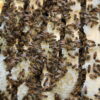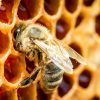Nucleus Colony
Finding a local beekeeper that sells starter colonies, known as Nucleus colonies of bees, or ‘Nuc’ is essential
Where Do I Put My Hive?
You need to find a location for your hives. You don’t need a lot of space, but you need the right conditions.
Here is a list:
Must haves:
- At least 20 feet of room for bees to fly unobstructed. They will need a “flightpath” out of the hives where people aren’t walking.
- Sunshine in the morning
- A flat, level surface
- Access to this space 24/7 without needing to make arrangements.
- Located at least 100 feet from sidewalks, doors, pet areas, and any other areas that see heavy people/pet activity.
- Not too windy or places where temperature swings are minimal. Rooftops are difficult places to learn beekeeping.
- A good water source nearby, either provided by you or a natural source like a creek. Bees prefer pool water or a drippy faucet on soil for some reason.
- Urban areas with lots of irrigated gardens around them
- Places where they cannot be seen from the road or by neighbors
- Places where you can keep more than one hive, since they can share resources when you pair them up.
- Space between your hives so that bees know which one is their own. The hives in this photo are very close together, not ideal but makes for a pretty photo and easier to work this way.
Preparing With Hive Set-up
What equipment do I need?
You need to choose the right kit system that works best for you. Best to keep it simple and increase complexity as you know more. There are many types or systems you can choose from, we’ll mention the most common in the UK
Langstroth Hives: these are most common and preferred to beekeepers
BS or National Beehive: the frames are a bit smaller than the Langstroth ones.
WBC Hives: double wall hives their frames are the same size as the National.
Smith hive: is popular in Scotland especially the Borders where it originates from. Its a single walled hive and is easy to handle and manipulate.
Tools:
You will also need a base to set the hive on, since it doesn’t do well on the ground. Use mason blocks from any hardware store, a sturdy palette, Remember, it needs to be level!
Hiving Your Nuc
Your bees will orient themselves to their new locations based on polarized vision and recognizable landmarks. Bees will orient themselves so they can find their new hives, and if they orient themselves to the wrong part of your garden, they won’t be able to find home.
What you do is place your nuc box right next to where the new hive awaits. The bees will then be able to shift over a few inches to find the hive as you make the transfer. If the bees cannot be move into their new hive right away, place the nuc box in the spot your hive will be and allow the bees out to forage. When you move them into the hive keep it in that spot and they will already know where home is.
Fire up your smoker and give the entrance of the nuc box a puff or two of cool smoke. This will ensure the guard bees at the entrance are calm and you don’t get a big reaction your first time opening the hive. Smoke interrupts the ability of bees to signal danger. There are only a few dozen bees in nucs who are programmed to signal danger, but if they get fired up, others will join in the cause. This is why smoke is the universal tool for all beekeepers worldwide, no matter if they keep bees in traditional ways or our more modern systems. Don’t skip the smoke because you’re concerned about the health and wellbeing of the bees- this is a foolish notion based on a failure to understand honeybees. Bees are amazing and wonderful, sentient creatures, but it is in their nature to sting, and they have just been through some trauma while on their trip to your apiary, so do not set yourself up for failure on your first day. It will be less stressful for you and your bees, because you will make fewer mistakes as a new beekeeper when you get prevent yourself from getting stung and keep a cool head.
Make a space in the hive box by pushing the empty frames to either side of the hive. The frames from your nuc go into their new hive in the center, with brood in the very center and resources on either side, and finally the empty new frames on either side. As your bees consume their resources they will be foraging for new resources, which they will begin putting in new combs as they expand. The old honey and pollen combs will become brood comb where eggs will be as the colony occupies more frames.
It’s not a bad idea to feed nucs when they are in their new home, at least until they have filed out the first box with bees and resources. This box must be full before winter at the very least, and feeding helps the bees build wax. It takes many pounds of honey or other carbohydrate sugars to produce small amounts of wax, and without wax its hard to make new bees to gather honey and there’s nowhere to put honey if there isn’t any comb.
Don’t spend too much time moving the nuc into their new hive. They’re bound to be grumpy, so you won’t see them at their best, and being quick will be better for everyone.
Remember to check and make sure the hive entrance is at its smallest opening so the small hive can defend itself from other bees who may rob them and from Wasps or Hornets.
Inspecting Your New Hive
Save your first inspection for a few days after you’ve placed your nuc in their new box so you aren’t trying to do it while the bees are stressed.
Inspections this time of year will be to assess the build-up of the hive’s population, how well they are building new comb and if they need more room, and how their overall health looks. A nucleus colony will have a minimal tendency to swarm if setup correctly and promptly, so don’t worry too much about that for a while.
You don’t need to see the queen, Just look for her eggs. When you see eggs, stop looking for the queen. Its very important not to keep frames out too long, because they need to be kept at a stable temperature for the larvae to develop properly. It stresses the bees to have frames out too long, and sometimes foreign bees can start robbing the frames of honey. How long is too long? Depends on the temp and situation, but if you always try and make it quick, then you’ll be fine.
Look at the brood next. Healthy hives have brood that is grouped in rings of the same age. Capped areas should be fairly uniform with cells mostly capped, not too many gaps. Look at the larvae and make sure the smallest ones are “wet” looking, not dry. Look for dead larvae. Take notes.
More About Feeding Bees
In addition to sugar, the bees need pollen. Bee supply stores sell pre-made patties, and you can make your own with powdered commercial pollen supplement or by mixing your own with raw ingredients. The pollen patties should be added as close to brood as possible, and in this case I’d put them right on top of your frames where they can get to them easily. Remember to place the patties to that bees can still get around them!




